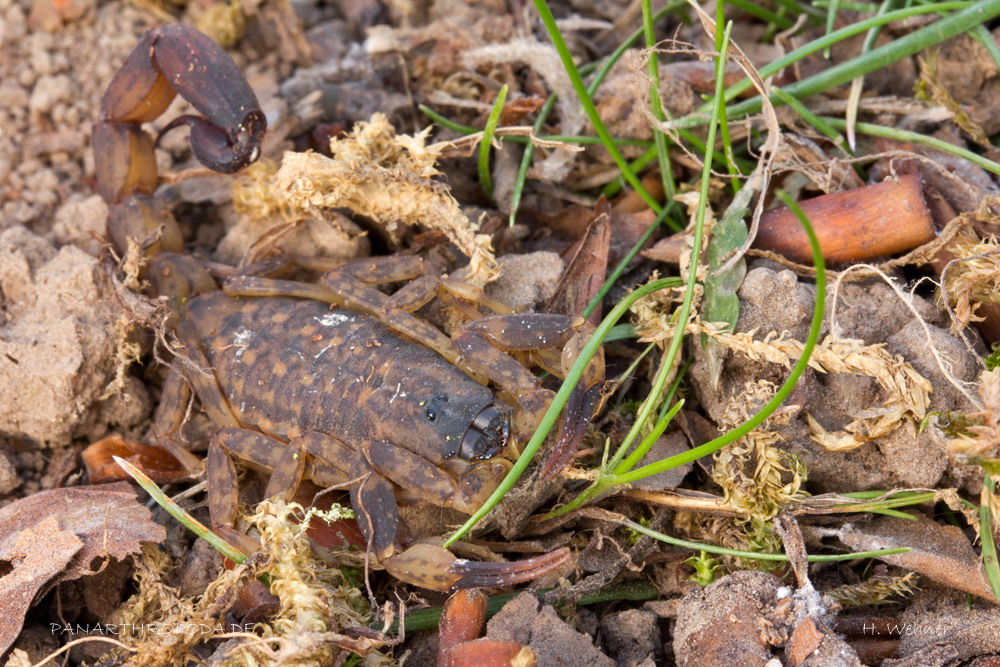- Akravidae
- Bothriuridae
- Buthidae
- Babycurus jacksoni
- Centruroides gracilis
- Centruroides meisei
- Centruroides nigrenscens
- Hottentotta hottentotta
- Lychas mucronatus
- Lychas scutilus
- Parabuthus pallidus
- Parabuthus raudus
- Parabuthus villosus "black"
- Caraboctonidae
- Chactidae
- Chaerilidae
- Euscorpiidae
- Hemiscorpiidae
- Iuridae
- Pseudochactidae
- Scorpionidae
- Superstitioniidae
- Troglotayosicidae
- Typhlochactidae
- Vaejovidae

Lychas mucronatus (Fabricius, 1798)

Adult specimen
Origin and occurrence
Lychas mucronatus is a quite wide-spread species of scorpion. The known area of distribution spans India, China, Japan, Myanmar, Laos, Cambodia, Thailand, Vietnam, Malaysia and the indonesian islands including the Philippines (KOVARIK 1995). It is however not clear how far into India and China this species is distributed. The tropical and all year warm climate of Southeast Asia is coined by a time of rain and a time of dryness. There are however big local fluctuations in these seasons, which makes universal statements about the climates of the habibats of Lychas mucronatus quite difficult. The time of dryness needn't be taken into account when keeping this species though. My specimen originated from China.
Appearance and sexual dimorphism
Lychas mucronatus is a species of average size, which reaches about 4 – 6 cm in bodysize. It's basecolor is beige with brown marbleization. The telson and the fingers of the chelae are colored red. The black mask between the median eyes and the chelicerae is characteristic for this species.
The sexes of this species are easily distinguished. In adult specimen this can be done by looking at the chalae and mani. The fingers of the male's chalae are arched, which produces an clearance between the fingers. In females this clearance is not present. Furthermore, the female's mani are a little smaller.
In addition, the females are bulkier in their build than the slender males. I can not confirm statements about adult males beeing longer then adult femlales.
In juveniles sexing can be a problem due to a crossover in the pectinal teeth count. Females have 19 - 22 pectinal teeth, males 21 - 23 (Kovarik 1995). So only juvenile specimen with 19, 20 or 23 pectinal teeth can be sexed properly.
Behavior
Lychas mucronatus is a very calm species of scorpion. They will almost never show any signs of threatening or even stringing, but flee - even though this will mostly be done when disturbed over a longer period of time.
As a bark-living scorpion they will avoid the ground and instead favor bark, that is used for climbimg and hiding. The container should therefore contain several upright pieces of bark to offer a bigger walking area and several niches for hiding in.
Lychas mucronatus is mainly nocturnal, but shows ifself during day more frequently compared to other species. Aggression inside groups is small to nonexistent. Adult specimen can be kept in groups without a problem (they even share hideouts and sit next or on top of each other), in juvenile specimen one should account for cannibalism.
Keeping conditions
A container measuring 20x20x20 cm can house of group of up to 10 adult specimen, since Lychas mucronatus will stay rather small. As a bark-living scorpion this species perfers upright pieces of bark that are used for hiding and climbing. In doubt a higher then wider container makes more sense since this species will use the height more then the surface on the ground.
Temperatures of about 26 - 28 °C during day and about 20 °C during night should be reached. Temperatures of up to 30° C during day are however tolerated and will even accelerate the growth and shorten the gestation time. To reach a constant high humidity one should keep an eye on not letting the substrat (e.g. humus) dry out completely. A shallow bowl of water can be offered to (be advised of the danger of drowning). Because of the high humidity one should at all costs keep in mind to remove rests of prey quickly, since otherwise the danger of molds and mites is rather hight. For adults medium crickets are sufficient as prey.
Mating and raising the young
Mating Lychas mucronatus is no problem. When kept in groups mating will occur several times. Of course one should keep in mind that fitting pieces of bark or flat stones are needed for placing the spermatophore.
The females will litter 3 to 4 months after fertilization. With perfect keeping conditions this time can be reduced to 10 weeks (personal experience). The litter contains about 20 to 30 young.
After molting into second instar they will leave the mother's back a few days later and become autonomous. They can then be fed with prey reaching their own size, like small crickets.
A high humidity is essential for the proper growth of the young. As mentioned the container should be kept clean to avoid molds and mites. A too low humidity will result in death of the young by dehydration or problems during molt.
The young will reach adulthood after 6 to 7 months. The males reach adulthood in 5. instar, the females in 6. Because of the risk of cannibalism raising the young seperately should be preferred.
A. Weide
